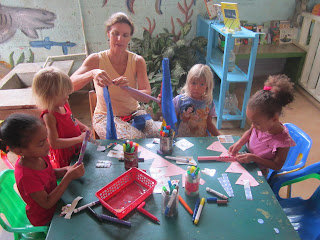The Tainos were the native people living on the island of Hispaniola when Columbus arrived there. Many of the children in the class know some traditional stories of Taino resistance to the Spanish invaders such as the story of Anacaona (for whom the library is named) and the story of Chief Enrequillo. While talking about these stories with my class I decided to do some research on the Tainos and then asked the class if they would be interested in learning more about these people and the history of Hispaniola. It turned out to be a great unit, and as we learned about the Tainos we reinforced other skills we have been working on throughout the year.

The story of Anacaona has become a legend that is part of the cultural fabric both in the Dominican Republic and in Haiti, and there are many different versions of the tale. Anacaona was part of a powerful Taino family and ended up a chief in her own right, known for her writing, songs and poetry. She was optimistic when Columbus first arrived and was part of initial negotiations, however she later realized the intention of the Spanish forces. There are differing accounts about the degree to which she aided in the resistance effort and the Taino revolt, but most stories say that she was arrested and executed during what was supposed to be a peaceful meeting. Many people say that Anacaona was given a choice between execution and becoming the wife or concubine of one of the Spaniards and that she chose execution. Many people on the island remember the tale of Anacaona today, and the class was excited to learn about her day to day life.
First we talked about how the Tainos lived, what they ate, how they cooked their food and what their homes and communities looked like. Here we practice fishing and counting.
Tainos were one of the first people to use hammocks and Europeans took the idea and began to use hammocks in their boats to prevent seasickness at night. We made our own hammock and tried it out.
Sisa catching fish with a "net," and Rosangela making fish soup over a fire.
During morning free play I put out some books and open ended materials for Taino dramatic play. The story Encuentro by Jane Yolen was a really beautifully written story of the first encounter between the Tainos and Columbus' men seen through the eyes of a child.
Hammock, pond for fishing and materials for dramatic play
Cooking
More cooking
As one of our activities we wove baskets, a craft that the Tainos excelled at. Using natural materials, fabric and sticks we made our own.
Experimenting with different materials
Weaving
Lining the basket so the inside is soft
Using fabric
Dileni cutting
The Tainos were also know for their pottery. We were lucky to have a few very old artifacts that we could examine.
After learning about the techniques used by the Tainos to make clay pots, the class chose and made coil or pinch pots with clay.
Ana and Sisa showing their creations
Hard at work
Nearby in Haitisis National Pak as well as in several other caves across the island, pictographs and pictograms have been preserved in the stone of the caves. The Tainos used these symbols to tell stories. They represented religious rituals and scenes from everyday life. After reading about caves and the pictograms we were curious to make our own.
We had to improvise a little to make the cave, but were able to see how it would be to write or carve on the walls right in our classroom.
Our final cave drawings.
This was a really fun unit. I learned so much and the kids shared stories and knowledge with each other.
























































